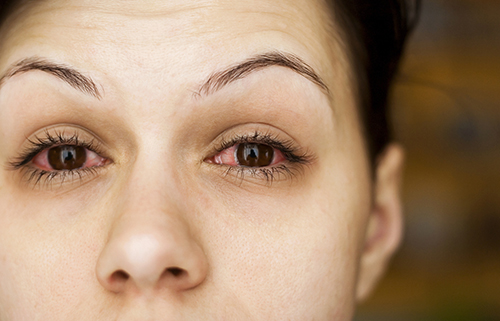Scleritis & Uveitis
Scleritis

Scleritis is a condition characterized by inflammation of the white part of the eye. In the United States, most cases of scleritis are associated with auto-immune diseases such as rheumatoid arthritis, Crohn’s disease, and other vasculitis; however, infections, especially herpes, may also be associated. A common misconception is that rheumatoid arthritis causes scleritis. Scleritis may occur in patients with rheumatoid arthritis, but it is a separate manifestation of the autoimmune disease. The overactive immune system in a patient with an autoimmune disease causes inflammation in the joints in rheumatoid arthritis much like it causes ocular inflammation in scleritis.
Scleritis is extremely painful; patients with scleritis typically describe the pain as “stabbing.” In addition, the eye is very tender to the touch. The redness of an eye with scleritis is typically dark red and sometime purplish. Light sensitivity is also common. Sometimes, there is loss of vision.
When the inflammation becomes so intense that the blood vessels to the site of scleritis become occluded, necrosis can occur. Necrotizing scleritis is a severe form of scleritis, almost always associated with severe systemic autoimmune disease.
Non-infectious scleritis tends to be chronic and requires long term therapy. In general, therapy with eye drops is not effective. Non-steroidal anti-inflammatory drugs (NSAID), similar to ibuprofen, are the treatment of choice. In cases that don’t respond to NSAIDs, oral steroids or injections may be needed. For steroid-dependent cases, immunomodulatory therapy such as methotrexate, mycophenolate or infliximab may be used as steroid sparing agents. In cases of necrotizing scleritis, chemotherapy such as cyclophosphamide may be necessary.
Fortunately, scleritis rare; however, because it is rare, it is frequently misdiagnosed, most commonly as conjunctivitis (pink eye) or allergies. It is important to diagnose and to treat scleritis promptly, not only because it is potentially sight threatening, but because scleritis is often the first manifestation of a life threatening systemic disease that requires urgent attention.
Uveitis
What is Uveitis?
Uveitis is inflammation of the middle layer of the eye, which contains much of the eye’s blood vessels. The uvea is the pigmented inside layer of the eye, lying beneath the sclera and cornea, and comprises the iris, choroid, and ciliary body. The term Uveitis is frequently used for any inflammation of the interior of the eye. Infections, injury and autoimmune disorders may be associated with the development of uveitis, though the exact cause is often unknown. Uveitis disrupts vision by primarily causing problems with the lens, retina, optic nerve, and vitreous.
Uveitis FACTS
- According to the CDC (Centers for Disease Control and Prevention), USA, approximately 10% of all cases of blindness in the United States are caused by uveitis.
- Uveitis disrupts vision by primarily causing problems with the lens, retina, optic nerve, and vitreous.
- The National Eye Institute conducts and supports a number of studies investigating uveitis, including, testing new methods for treating uveitis.
- MERSI is actively conducting Researchon Uveitis and offers several clinical trials for this condition
Symptoms of Uveitis:
- Blurred vision
- Cloudy vision
- Floaters
- General vision problems
- Eye pain
- Eye redness
- Photophobia – abnormal sensitivity to light
- Headaches
- A small pupil
- Alteration of the color of the iris
Types of Uveitis
- Anterior uveitis frequently termed iritis. This type affects the front of the eye.
- Inflammation of the iris (iritis) is the most common type of uveitis.
- Intermediate uveitis – consists of vitritis, inflammation of the jelly-like part of the eye (vitreous cavity). When there is inflammatory material on the pars plana, the condition is called pars planitis
- Posterior uveitis – inflammation of the retina and choroid. Posterior refers to the back of the eye.
- Pan-uveitis – is when inflammation exists in all layers of the uvea.

